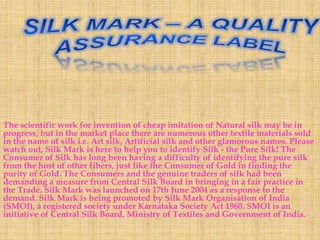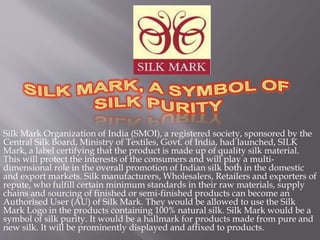The shahtoosh shawl trade has been banned in Jammu and Kashmir in accordance with wildlife protection policies. Shahtoosh shawls are made from the down fur of endangered Tibetan antelopes, whose population has sharply declined from around 1 million to less than 75,000 due to hunting for their fur. Animal rights and environmental groups have welcomed the ban to help protect the antelopes, though it will significantly reduce state revenues from the lucrative shawl trade.

![Certifying agency Silk Mark Organisation of India Effective since 2004
Product category Silk textile Legal status Advisory Website
silkmarkindia.com Silk Mark is a certification mark in India for silk textiles.
The mark certifies that the piece of textile which bears the mark is made of
pure natural silk. The certification is managed by the 'Silk Mark
Organisation of India', a society setup by the state controlled Central Silk
Board of India.[1] Even though promoted by the government of India, the
mark is only advisory in nature and is not legally endorsed. The certification
scheme was founded by the Central Silk Board in 2004.In the original format,
the mark included a silk mark logo woven on a hang-on tag on which a
unique numbered hologram would be affixed. But the hang-on tag tended to](https://image.slidesharecdn.com/silkmarkstd7-161106124418/85/Silk-mark-2-320.jpg)








